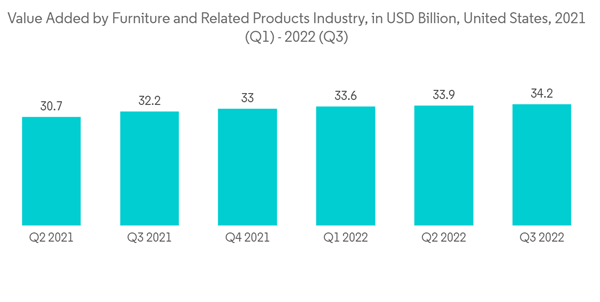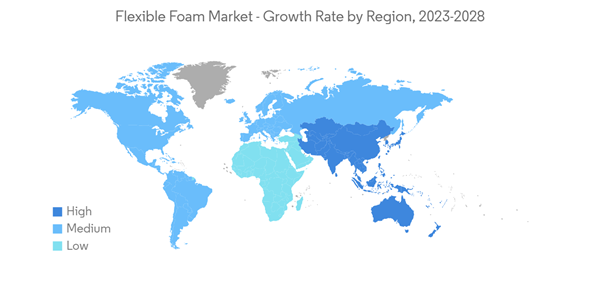The flexible foam market is projected to register a CAGR of over 7% during the forecast period.
COVID-19 hurt the market for flexible foam because there was a big drop in demand from the construction, furniture, and auto industries.The lockdown hurt the building industry because many projects were put on hold, which led to less demand for furniture in homes and offices.However, the market gained pace in 2021 and is expected to grow at a healthy rate during the forecast period.
This product will be delivered within 2 business days.
COVID-19 hurt the market for flexible foam because there was a big drop in demand from the construction, furniture, and auto industries.The lockdown hurt the building industry because many projects were put on hold, which led to less demand for furniture in homes and offices.However, the market gained pace in 2021 and is expected to grow at a healthy rate during the forecast period.
Key Highlights
- The packaging industry's growing need for flexible foam material is the main thing that will drive the market studied over the next few years.Also, more carpet cushions are being made with flexible foam, which is expected to increase demand for the market studied.
- But the process of making flexible foam materials, which is expensive, is likely to slow the growth of the market studied.
- During the time frame of the forecast, the market is likely to benefit from the growing demand for cushion seats in electric vehicles.
- The Asia-Pacific region is expected to dominate the market globally, with the most consumption coming from countries such as China, India, and Japan.
Flexible Foam Market Trends
Growing Demand for Flexible Foam in Furniture Industry
- Flexible foam is widely used in various industrial applications, due to its reliability in the sector. Apart from the excellent properties, the reduction of the cost of raw materials is a significant advantage in using these materials.
- Flexible foam is used in furniture applications, owing to the versatility of the product as a structural material. Some of the characteristics of flexible foam, such as being lightweight, anti-microbial, and its ability to mold into a wide range of shapes, makes it usable in a wide range of furniture applications, such as child stools, office wall partition, and bookshelves.
- IKEA, a well-known international retailer of home furnishings, reported in its annual report that its yearly revenue climbed by almost 6% between 2021 and 2022, when its sales were EUR 41.9 billion (USD 45 billion) and EUR 44.6 billion (USD 61.2 billion), respectively.
- The Bureau of Economic Analysis also estimated that the value contributed by the furniture and related products industry in the third quarter of 2022 in the United States was about USD 34 billion at a seasonally adjusted rate, or about 6% greater than the value added for the same time period the previous year. Over the first three quarters of 2022, the value added by the furniture and related products industry was roughly USD 101.7 billion.
- Moreover, according to Office for National Statistics (UK), In 2021, United Kingdom households purchased approximately GBP 24.5 billion (~USD 33.7 billion) worth of furniture and furnishings, up from GBP 24.13 billion (~USD 33.05 billion) purchase registered a year earlier.
- Owing to the factors mentioned above, the application of flexible foam material as an alternative in the furniture industry is expected to dominate during the forecast period.
Asia-Pacific Region to Dominate the Market
- Over the next few years, the flexible foam market is expected to be led by the Asia-Pacific region.Market growth is expected to be affected by the rise in demand for the product from the region's many end-user industries, such as furniture, packaging, consumer goods, and automotive.
- Flexible foam is a popular type of polyurethane foam that is lightweight, durable, and can be molded into many shapes. It is often used to make the inside of cars more comfortable and to insulate homes against heat loss.
- China, which makes and uses the most auto parts in the world, is expected to have the highest demand for flexible foam.The Chinese Association of Automobile Manufacturers says that China made 3.4% more cars in 2022 than it did the year before.In 2022, roughly 27 million vehicles were produced, up from 26.08 million units in 2021.
- Furthermore, with the growing automotive industry in Japan, various car manufacturers expanded their production capacity in the country. According to the Japan Automobile Dealers Association (JADA), Toyota will be the leading car manufacturer in Japan in 2022, selling around 1.25 million vehicles domestically, followed by Suzuki, which sold slightly over 600,000 vehicles domestically in the same year. This in turn would increase the need for flexible foam for cushioning, thus driving the market forward.
- Because of the country's growing population, China is predicted to have a huge fraction of the world's furniture business, owing to the need for furniture in residential areas, offices, and other locations. According to the National Bureau of Statistics of China, retail sales of furniture in China in December 2022 were roughly CNY 17.4 billion (USD 2.5 billion). This, though, amounted to a 5.8 percent decline in revenue compared to the same time the prior year. Nonetheless, a 3% rise in sales was noted when compared to the revenue generated in November 2022.
- Moreover, according to the Statistics Bureau of Japan and a survey conducted by the Ministry of Economy, Trade, and Industry of Japan, furniture and home furnishings sales in Japan's wholesale sector reached around JPY 4.5 trillion (USD 41.06 billion) in 2021, reaching a decade-high.
- Because of this, the market for flexible foam material in the Asia-Pacific region is expected to grow a lot during the study period. This is because many industries are growing.
Flexible Foam Industry Overview
The flexible foam market is partially fragmented, with only a few major players dominating the market. Some of the major companies are BASF SE, Rogers Corporation, Huntsman International LLC, Inoac Corporation, and Recticel NV/SA, among others (not in any particular order).Additional Benefits:
- The market estimate (ME) sheet in Excel format
- 3 months of analyst support
This product will be delivered within 2 business days.
Table of Contents
1 INTRODUCTION1.1 Study Assumptions
1.2 Scope of the Study
2 RESEARCH METHODOLOGY
3 EXECUTIVE SUMMARY
4 MARKET DYNAMICS
4.1 Drivers
4.1.1 Growing Demand of Flexible Foam in Packaging
4.1.2 Increasing Demand for Flexible Foam in Carpet Cushion
4.1.3 Other Drivers
4.2 Restraints
4.2.1 Environmental Degradation while Fabrication
4.2.2 Other Restraints
4.3 Industry Value Chain Analysis
4.4 Porter's Five Forces Analysis
4.4.1 Bargaining Power of Suppliers
4.4.2 Bargaining Power of Buyers
4.4.3 Threat of New Entrants
4.4.4 Threat of Substitute Products
4.4.5 Degree of Competition
4.5 Raw Material Analysis
5 MARKET SEGMENTATION (Market Size in Value)
5.1 Type
5.1.1 Polyurethane
5.1.1.1 Polyester
5.1.1.2 Polyether
5.1.2 Polyethylene
5.1.2.1 Cross linked
5.1.2.2 Non-cross linked
5.1.3 Polypropylene
5.2 Application
5.2.1 Construction
5.2.2 Consumer Goods
5.2.3 Furniture
5.2.4 Transportation
5.2.5 Other Applications
5.3 Geography
5.3.1 Asia-Pacific
5.3.1.1 China
5.3.1.2 India
5.3.1.3 Japan
5.3.1.4 South Korea
5.3.1.5 Rest of Asia-Pacific
5.3.2 North America
5.3.2.1 United States
5.3.2.2 Canada
5.3.2.3 Mexico
5.3.3 Europe
5.3.3.1 Germany
5.3.3.2 United Kingdom
5.3.3.3 Italy
5.3.3.4 France
5.3.3.5 Rest of Europe
5.3.4 South America
5.3.4.1 Brazil
5.3.4.2 Argentina
5.3.4.3 Rest of South America
5.3.5 Middle-East and Africa
5.3.5.1 Saudi Arabia
5.3.5.2 South Africa
5.3.5.3 Rest of Middle-East and Africa
6 COMPETITIVE LANDSCAPE
6.1 Mergers and Acquisitions, Joint Ventures, Collaborations, and Agreements
6.2 Market Share (%) Analysis **/ Market Ranking Analysis
6.3 Strategies Adopted by Leading Players
6.4 Company Profiles
6.4.1 American Excelsior Company
6.4.2 BASF SE
6.4.3 Carpenter Co.
6.4.4 Changzhou Xingang Plastic Products Co., Ltd.
6.4.5 Covestro AG
6.4.6 Dow
6.4.7 Greiner AG
6.4.8 Huntsman International LLC
6.4.9 Inoac Corporation
6.4.10 KANEKA CORPORATION
6.4.11 ORSA foam SpA
6.4.12 Recticel NV/SA
6.4.13 Rogers Corporation
6.4.14 SEKISUI CHEMICAL CO., LTD.
6.4.15 Sheela Foam Ltd
6.4.16 Wm. T. Burnett & Co.
6.4.17 Woodbridge
7 MARKET OPPORTUNITIES AND FUTURE TRENDS
7.1 Increasing Demand for Cushion Seats in the Electric Vehicles Segment
7.2 Other Opportunities
Companies Mentioned (Partial List)
A selection of companies mentioned in this report includes, but is not limited to:
- American Excelsior Company
- BASF SE
- Carpenter Co.
- Changzhou Xingang Plastic Products Co., Ltd.
- Covestro AG
- Dow
- Greiner AG
- Huntsman International LLC
- Inoac Corporation
- KANEKA CORPORATION
- ORSA foam SpA
- Recticel NV/SA
- Rogers Corporation
- SEKISUI CHEMICAL CO., LTD.
- Sheela Foam Ltd
- Wm. T. Burnett & Co.
- Woodbridge
Methodology

LOADING...










